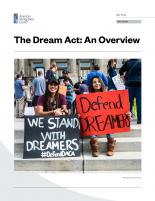- Fact Sheet
The Dream Act: An Overview
The Dream Act, DACA, and Other Policies Designed to Protect Dreamers
Modified
Published
The Dream Act: An Overview
What is the Dream Act?
The Dream Act is proposed legislation that would permanently protect certain immigrants who came to the United States as children but are vulnerable to deportation.
The first version of the Development, Relief, and Education for Alien Minors (DREAM) Act was introduced in 2001. In part because of the publicity around that bill, young undocumented immigrants have been referred to as “Dreamers.” Over the past 20 years, at least 20 versions of the Dream Act have been introduced in Congress. While the various versions of the bill have contained some key differences, they all would have provided a pathway to legal status for undocumented people who came to this country as children.
Some versions of the Dream Act have garnered as many as 48 cosponsors in the U.S. Senate and 205 in the House of Representatives. However, despite bipartisan support for each iteration of the bill, none have become law. To date, the 2010 bill came closest to full passage when it passed the House but fell just five votes short of the 60 needed to proceed in the Senate.
This fact sheet provides an overview of the most recent version of the Dream Act introduced in the 118th Congress and similar legislative proposals.
Current Federal Legislative Proposals
There are three versions of the Dream Act currently before the 118th Congress: the Dream Act of 2023 (S. 365) and two versions of the Dream Act that are incorporated into larger bills, including the American Dream and Promise Act of 2023 (H.R. 16). In addition, the Dignity for Immigrants while Guarding our Nation to Ignite and Deliver the American Dream Act or “DIGNIDAD” (Dignity) Act of 2023 (H.R. 3599) includes the Dream and Promise Act.
The Dream Act of 2023 was introduced on February 9, 2023 in the Senate by Senators Dick Durbin and Lindsey Graham. The two senators introduced nearly identical legislation in the previous three sessions of Congress.
In the House, the American Dream and Promise Act of 2023 was introduced on June 15, 2023 by Representative Sylvia Garcia and the DIGNIDAD (Dignity) Act of 2023 was introduced on May 23, 2023 by Representative Maria Elvira Salazar.
All three bills would provide a path to citizenship for Dreamers.
Notably, H.R. 16 and H.R. 3599 expand the Dream Act to also provide a path to citizenship for “documented” Dreamers—minor children who entered the United States as derivatives on their parent’s temporary work visas but who are at risk of “aging out” of their temporary legal status when they turn 21. After aging out, they face the difficult choice to depart the United States or face potential deportation. However, H.R. 16 and H.R. 3599 would not protect all documented Dreamers as both only cover children admitted as derivatives on E-1, E-2, H-1B and L-1 temporary work visas. By contrast, S. 365 requires the applicant to be “inadmissible or deportable from the United States,” which would exclude children under 21 who are lawfully present based on their parents’ temporary work visas.
H.R. 16 and H.R. 3599 also provide a path to citizenship to beneficiaries of two humanitarian programs: Temporary Protected Status (TPS) and Deferred Enforced Departure (DED).
What Would the Dream Act Do?
All three current versions of the Dream Act would provide current, former, and future undocumented high school graduates and GED recipients a pathway to U.S. citizenship through college, work, or the armed services. The bills outline a three-step process, summarized below.
An individual would be eligible to obtain conditional permanent resident (CPR) status, which includes work authorization, if the person has Deferred Action for Childhood Arrivals (DACA) or meets all the following requirements:
- Came to the United States as a child.
- Has been admitted to an institution of higher education, has graduated high school or obtained a GED, or is currently enrolled in secondary school or a program assisting students to obtain a high school diploma or GED.
- Has not participated in the persecution of another person.
- Has not been convicted of certain crimes.
Under the terms of the bills, the Secretary of the Department of Homeland Security (DHS) can issue waivers of certain criminal offenses for humanitarian purposes, for family unity, or when the waiver is otherwise in the public interest.
Step 2: Lawful Permanent Residence
Anyone who maintains CPR status could obtain lawful permanent residence (LPR status or a “green card”) by satisfying one of the following requirements.
- Higher education: the person has obtained a degree from an institution of higher education or a post-secondary credential from a career and technical education school.
- Military service: the person completed at least two years (H.R. 3599 requires at least three years) of military service with an honorable discharge, if discharged.
- Work: the person demonstrated employment over a total period of three years (H.R. 3599 requires at least four years) and at least 75 percent of that time the individual had employment authorization.
Individuals who cannot meet one of these requirements could apply for a “hardship waiver” if the applicant is a person with a disability; a full-time caregiver; or for whom removal would cause hardship (S. 365 requires extreme hardship) to themselves or a spouse, parent, or child who is a national or lawful permanent resident of the United States.
Step 3: Naturalization
After maintaining LPR status for five years, an individual can generally apply to become a U.S. citizen through the normal naturalization process.
Who Would Benefit from the Dream Act, H.R. 16, and H.R. 3599?
The three bills differ in how many people would qualify for CPR status due to variations in their requirements for length of stay in the U.S. and age at arrival.
Under each bill, some people would become immediately eligible for CPR status when the bill became law, and an additional group of approximately 300,000 people would have the possibility of eventually becoming eligible by meeting the educational and/or age requirements.
Estimated number of Dreamers who would qualify for CPR status
|
Bill |
Immediately eligible |
Total potentially eligible |
|
H.R. 3599 |
1,767,700 |
2,058,800 |
|
H.R. 16 |
1,789,000 |
2,080,000 |
|
S. 365 |
1,564,700 |
1,855,800 |
Key Differences between S. 365, H.R. 16, and H.R. 3599
The three bills have some significant differences around qualification requirements for conditional resident status, which are compared below.
|
Eligibility |
S. 365 |
H.R. 16 |
H.R. 3599 |
|
Age of arrival |
17 years old or younger
|
18 years old or younger |
18 years old or younger |
|
Has been continuously physically present since: |
Four years prior to bill enactment |
January 1, 2021 |
Three years prior to bill enactment |
|
Validity period of conditional permanent residence |
8 years
|
10 years
|
10 years |
|
Disqualifying criminal history (convictions) |
|
|
|
|
Exceptions |
|
|
|
|
Special procedure for DACA recipients to bypass conditional residency |
No |
Yes |
Yes |
Secondary Review Process in H.R. 16 and H.R. 3599
In addition to the criminal bars listed above, H.R. 16 and H.R. 3599 contain a secondary review process that would allow DHS to deny applications from individuals deemed to be threats to public safety and those who have participated in a gang within the last five years.
DHS would be allowed to conduct a secondary review of an application if the person has been convicted of any misdemeanor that is punishable by more than 30 days in jail, except those related to lack of immigration status, certain cannabis-related offenses, and nonviolent civil disobedience. A person is also subject to secondary review if the person has been the subject of a juvenile delinquency judgment and had to spend time in a detention facility. If DHS determines that the person is a threat to public safety, the agency can then deny the application.
DHS can also deny the application of a person that it determines has participated in a gang within the past five years. Despite provisions limiting the use of unreliable Immigration and Customs Enforcement (ICE) “gang” databases, youth advocates have expressed concern that gang membership allegations often rely on flawed information and result from over-policing and racial profiling.
H.R. 16 and H.R. 3599 also include several other provisions that are not included in S. 365. These bills:
- Repeal the 1996 law which penalizes states that grant in-state tuition to undocumented students based on residency and allows Dreamers to access federal financial aid.
- Allow eligible Dreamers deported under the Trump administration to apply for relief from outside the country.

